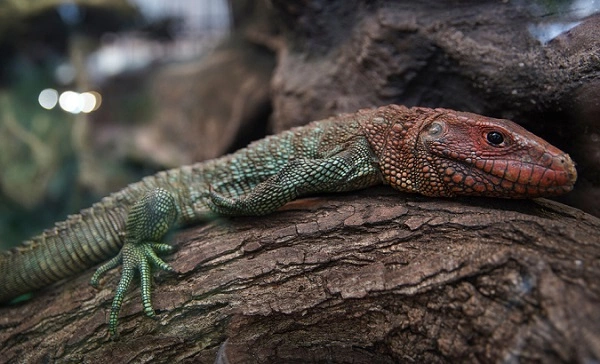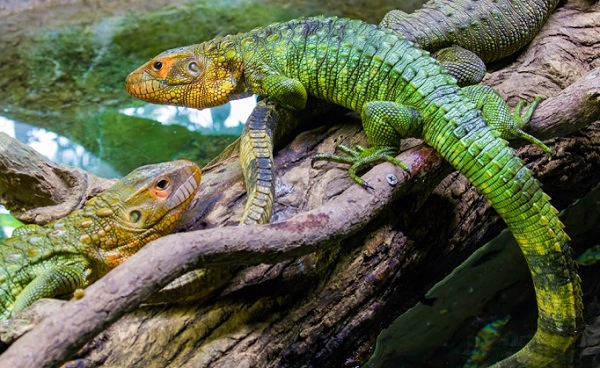If you’re looking for an interesting and exotic pet, a caiman lizard may be a perfect choice. These lizards come from South America, and they make fascinating pets. In this blog post, we’ll provide some basic information about caiman lizards, including their care needs and personality traits. We’ll also discuss why they make great pets for reptile enthusiasts of all levels of experience. So if you’re interested in learning more about these fascinating creatures, keep reading!

Caiman Lizard Description
Caiman lizards are large reptiles that are native to South America. They can grow up to six feet in length, and they are covered in armored scales. Caiman lizards are carnivorous, and they primarily hunt fish, amphibians, and small mammals. They are excellent swimmers, and they often enter the water in search of prey. Caiman lizards are also adept at climbing trees, and they often perch in branches in order to ambush their prey. Caiman lizards are solitary creatures, and they only come together to mate. Females lay up to 30 eggs at a time, which hatch after about two months. Caiman lizards typically live for 10-15 years in the wild.
Caiman Lizard Habitat
Caimans are a species of lizard that is native to South and Central America. They are typically found near water sources, such as rivers, lakes, and swamps. Caimans prefer habitats that are dense with vegetation, as this provides them with shelter from predators and the elements. Caimans are opportunistic feeders, and their diet consists of a variety of small animals, such as insects, fish, and rodents. Caimans play an important role in their ecosystems, as they help to control the population of their prey species. Caimans are hunted by humans for their skin, which is used to make leather goods. The Caiman trade is regulated by the Convention on International Trade in Endangered Species (CITES), which lists the Caiman Lizard under Appendix II. This means that trade in Caiman products is allowed, but only if it does not threaten the survival of the species.
Caiman Lizard Diet
Caiman lizards are native to parts of South America, where they can be found near bodies of water such as rivers and streams. These reptiles are predators, and their diet consists mainly of fish, amphibians, and crustaceans. Caiman lizards will also occasionally eat small mammals and reptiles. In captivity, these lizards can be fed a diet of live insects, pellets, and chopped fruits and vegetables. It is important to provide a varied diet to ensure that your caiman lizard receives all the nutrients it needs to stay healthy. Caiman lizards are excellent swimmers, and they often use their long tails to help them navigate through the water in search of food. These lizards are diurnal, meaning they are active during the day. At night, they will find a safe place to sleep, such as on a branch or in a burrow. Caiman lizards are typically solitary creatures, but they will often share their territory with other members of their species. These lizards are not considered to be threatened or endangered at this time.
Caiman Lizard Size
Caiman lizards are a large species of lizard that can grow up to six feet in length. They are native to South America and can be found in countries such as Brazil, Bolivia, and Paraguay. Caiman lizards are semi-aquatic animals and spend most of their time near water sources such as rivers and lakes. They are good swimmers and can even climb trees. Caiman lizards are carnivores and eat a variety of prey including fish, amphibians, reptiles, and small mammals. These lizards are shy by nature but can become aggressive if they feel threatened. Caiman lizards are popular pets due to their size and docile nature. However, they require a lot of care and should only be kept by experienced reptile owners.

Caiman Lizard Lifespan
The Caiman Lizard is a species of lizard that is native to South America. These lizards are known for their distinctive coloration, which can range from brown to green, and for their long tails. Caiman Lizards can grow up to 3 feet in length, and they have an average lifespan of 10 years. In the wild, these lizards are found in tropical rainforests, where they primarily eat insects and small mammals. Caiman Lizards are also popular pets, and they can be trained to perform tricks and even play fetch. When kept in captivity, these lizards typically live for 10-12 years. With proper care, Caiman Lizards can make lively and entertaining pets.
Caiman Lizard Behavior
Caiman lizards are a semi-aquatic species of lizard that is native to South America. They are typically found near bodies of water, such as rivers, swamps, and lakes. Caiman lizards are excellent swimmers and can even walk on the bottom of ponds and streams. When they are not in the water, caiman lizards basking in the sun or hiding in the underbrush. Caiman lizards are predators and will eat a variety of small animals, including fishes, frogs, and insects. They have powerful jaws and sharp teeth that enable them to catch and eat their prey. Caiman lizards are shy and reclusive animals that are not often seen by humans. However, they play an important role in the ecosystem by helping to control the populations of their prey species.
Caiman Lizard Speed
Caiman lizards are one of the fastest reptiles on the planet. They can reach speeds of up to 30 mph (48 km/h), making them one of the few animals that can outrun a human. Caiman lizards are native to Central and South America, where they inhabit swampy, forested areas. These lizards get their name from their resemblance to the caiman, a type of crocodilian. Caiman lizards are carnivorous, and their diet consists mostly of small mammals and birds. Caiman lizards are also known to eat insects, amphibians, and reptiles. These lizards are solitary creatures, and only come together to mate. Caiman lizards are capable of reaching lengths of up to 6 feet (1.8 meters). These lizards have been known to live for up to 10 years in captivity. Caiman lizards are popular pets, but they can be difficult to care for due to their high energy levels and special diet requirements.
Caiman Lizard Hunting
Caiman lizards are a type of large lizard that is found in the rainforests of South America. They are known for their distinctive scale patterns and their ability to change color. Caimans are also one of the few lizards that can swim, and they are often found near bodies of water. Caiman lizards are hunted for their meat, which is considered a delicacy in some cultures. The lizards are also hunted for their skins, which are used to make leather products. Caiman hunting is regulated by law in many countries, and only indigenous people are allowed to hunt them. Caiman hunting has been shown to have a negative impact on the environment, and it is therefore important to only hunt them sustainably.
Conclusion
The caiman lizard is a unique and fascinating creature. With its armored body, strong jaws, and predatory instincts, it is well-adapted to life in the wild. Whether you are looking for an interesting topic of conversation or want to learn more about these amazing animals, we hope this article has provided you with some valuable information. If you have any questions or would like to see additional content on caiman lizards, let us know.
Frequently Asked Question

